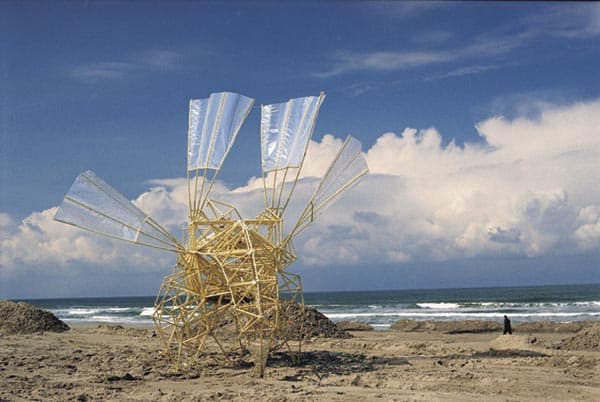Theo Jansen is a Dutch artist who builds animal-like structures out of plastic tubing that are able to “walk” using the wind. Once a year he releases them on the beaches of the Netherlands, and it is his hope that they will eventually be able to survive there indefinitely

Why did you originally choose to study physics?
I actually wanted to become a pilot but I wore glasses and in those days you couldn’t be a pilot if your eyes weren’t perfect. I had a nice physics teacher, so instead, to please him, I studied physics at the University of Delft. I didn’t enjoy it at all, however, especially in the beginning. I just didn’t get on well with university life. Despite staying there for seven years I didn’t get very far with my studies. I started painting and one day in 1975 I decided not to study physics any more and to concentrate on being an artist.
When did you move on from painting?
I painted for a long time, and then at the beginning of the 1980s I had the idea to make a flying saucer that floated on helium, to surprise people and distract them from daily life. I launched it over Delft and it caused panic in the streets. A film of it was broadcast on TV and after that I was famous for several months here in the Netherlands. After tasting so much fame I couldn’t sit still and paint anymore. Instead I decided to make machines, drawing on my physics background. At first I made a painting machine — essentially a spray gun that was sensitive to light — that reproduced what it saw in a room onto a wall. Then I read a book by Richard Dawkins that inspired me to make new forms of life.
How did you go about that?
I started with the idea that I could make wind-powered “animals” that would live on the beach and build up the dunes to save us from rising sea levels in the coming century. The creatures needed to be able to survive all the dangers of the beach, such as the water and the swamps, on their own. As I worked on these challenges I became more interested using the creatures to understand existing forms of life, and now that I’m getting older the motivation has changed again — I hope that when I die that I will live on through the beach animals.
How are these animals constructed?
The basic material of my new nature is the plastic conduit normally used to house electrical cables. I play with it and something is created. For instance, the animals have “muscles”, which are essentially pumps made of tubes of different sizes that are put together like pistons; and “senses”, in the form of a tube that trails over the ground sucking in air. When an animal arrives at the sea it swallows the water and feels the resistance of it, which prompts it to run out again.
Can the animals move when it is not windy?
The beach animals have now developed to the stage where they can store the wind, which is important because if the wind died down and the tide came up, then the animals would be washed away. As the wind sweeps over the back of the animal, it fills up empty soft-drinks bottles. The animals can use this spare energy to power their muscles to get back to the dunes. The muscles are linked together in a network — when filled with air they stretch, and when stretched they can open a valve, which allows another muscle to stretch, and so on. I’m about to hook this network up to a “brain”, which would also be connected to the animal’s senses. This will allow them to count their steps away from the sea using binary digits — once they know their position relative to the water they can avoid it.
How far away are self-sufficient animals?
I think it will take another four years before the animals can survive on the beach because storms, especially, are very mean. I need to add a clock so that the animals can predict the tides and run away before the water comes up. Also they don’t like pits on the beach, so they need to be able to detect those, and they need to be able to make their sails smaller when the wind is strong and to anchor themselves in the sand so that they don’t blow away.
Surely your physics training must help you with this work?
Yes. For example, to develop the leg system I wrote a genetic algorithm to calculate the length of the tubes needed. I’ve also needed to know about geometry, pneumatics and the logic networks that you can make with binary digits. I also think that a lot of physicists are more like artists than they might want to acknowledge. You need a lot of imagination to understand the world.
Do you still keep up to date with physics?
Not really. I don’t read very much about physics. Instead, I try to find it out for myself. Sometimes this leads me into awkward situations — for instance, for many years people told me to use o-rings to make the pistons. I always ignored their advice until someone made a piston for me and it turned out to work much better than the way I used to make them. But this is the way I prefer to work.
• For pictures and videos of Jansen’s beach animals in action visit his website strandbeest.com




